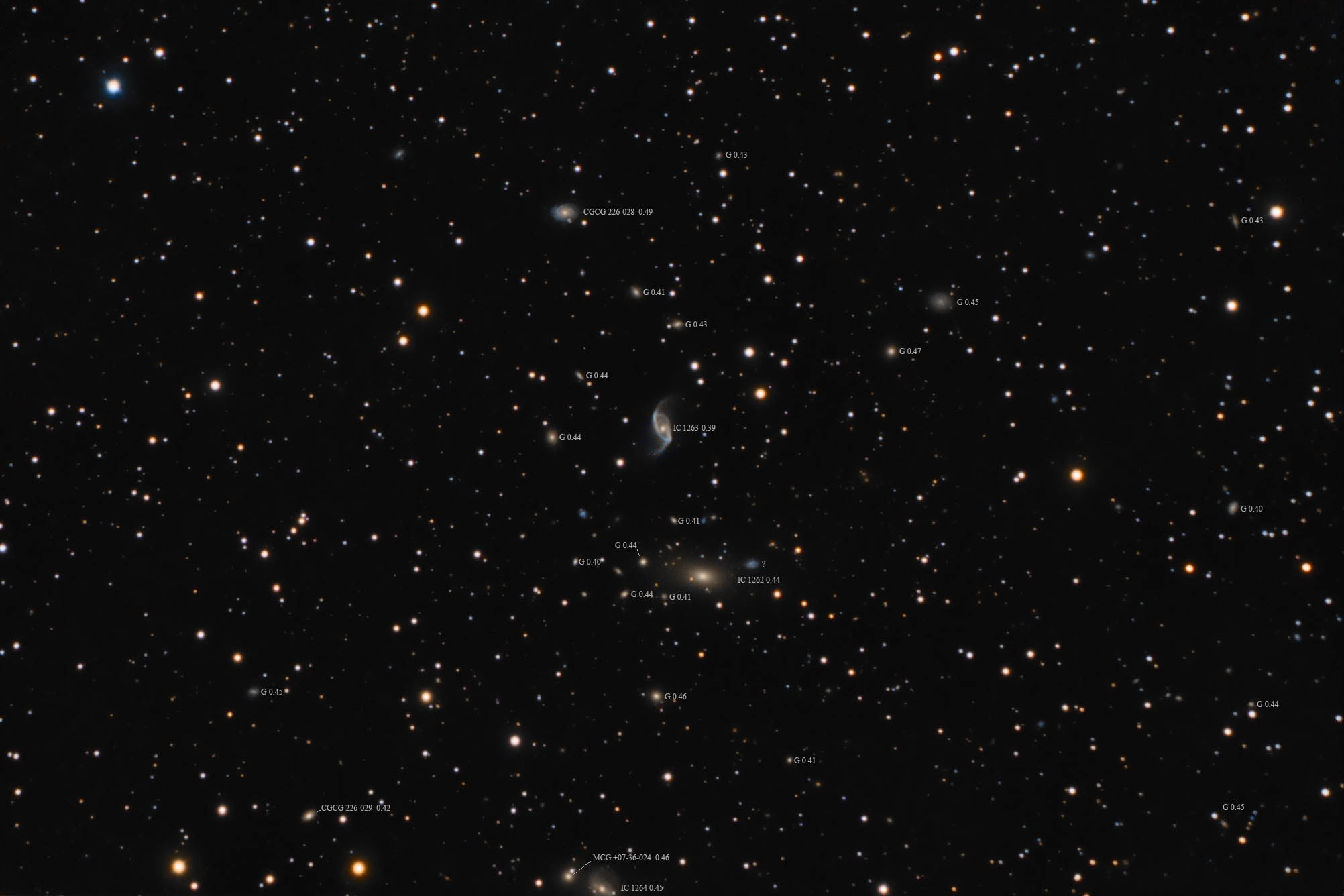| Description | Images |
Object name: IC1262Designation(s): IC1262, IC1263, IC1264, IC 1262 anchors a small cluster of galaxies. I've mentioned before I sometimes get requests, this one came from Sakib Rasool, a name I'm mentioning a lot of late. Not often do these make it onto my to-do list but this one did since the cluster contains the rather wacky galaxy IC 1263 to its north. As is obvious, I have a penchant for these. Maybe it's because my ham call sign, given me at random by the FCC over 55 years ago, is WA0CKY (the third character is a zero so my dad said the FCC knew I was a wacky nothing -- he was joking, I think). This field is located in Hercules not far from M92. The cluster is anchored by the elliptical cD galaxy IC 1262. Redshift puts it at about 440 million light-years from us. Though the distance to various members varies quite a bit due to rather high orbital motions of the cluster members. The cluster goes by many names, IC 1262 group, Zwicky 8239, WBL 643 and many others. Of course, the one I was told was Zwicky 8239 which isn't recognized by NED. Fortunately, Simbad did know of it. We have created quite a tower of Babel with these many catalog names for the same object, often with slightly different positions due to which galaxies they include and exclude. Related Designation(s):2MASS J17330201+4345349, 2MASS J17330721+4349193, 2MASS J17331681+4337449, 2MASX J17330202+4345345, 2MASX J17330719+4349195, 2MASX J17331686+4337455, 2MASXi J1733020+434535, 2MASXi J1733071+434919, 2MASXi J1733167+433745, 4C +43.46, CAN 072 NED01, CGCG 1731.5+4347, CGCG 1731.6+4351, CGCG 1731.8+4340, CGCG 226-025, CGCG 226-026, CGCG 226-027, CID 72:[HDH2012] BCG, GALEX J173301.8+434535, GALEXASC J173302.20+434535.5 , GALEXASC J173307.31+434917.3 , GALEXASC J173317.18+433746.3 , GALEXMSC J173301.96+434539.8 , GALEXMSC J173307.29+434919.7 , GALEXMSC J173316.86+433747.7 , GIN 639, IC 1262, IC 1263, IC 1264, IC1262, IC1263, IC1264, MCG +07-36-020, MCG +07-36-021, MCG +07-36-022, NFP J173302.0+434535, NFP J173307.2+434919, NFP J173316.8+433745, NSA 148072, NSA 148077, NSA 148086, NVSS J173302+434534, PGC 060479, PGC 060481, PGC 060484, RX J1733.0+4345:[CAE99], RX J1733.0+4345:[ZEH2003] 02 , SSTSL2 J173302.01+434535.5, SSTSL2 J173302.27+434532.6, UGC 10900, UGC 10902, UGC 10904, UZC J173302.1+434535, UZC J173307.2+434919, WBL 643-001, WBL 643-002, WBL 643-003, [CBW93] J24 A, [MB2007] J263.2586+43.7595, |

